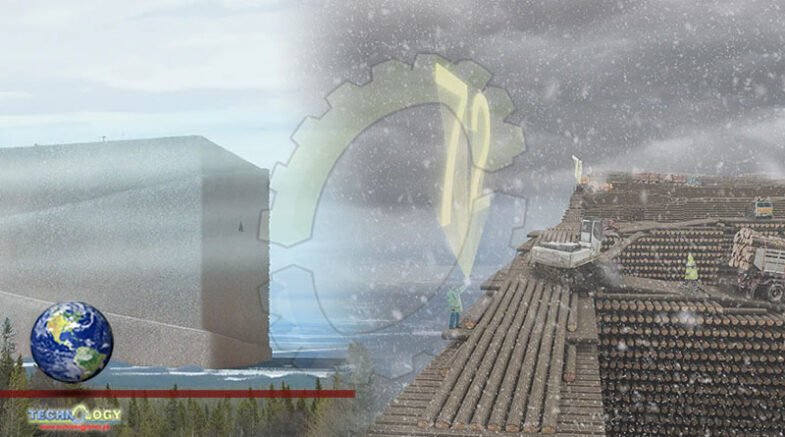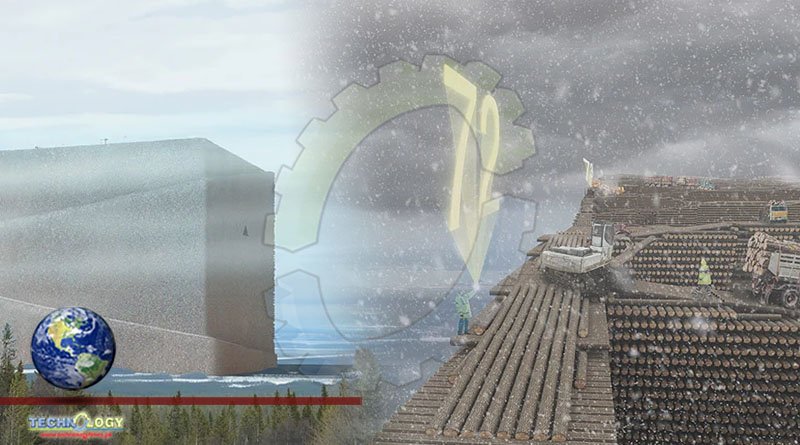In order to reduce the ‘green’ half of sweden’s carbon emissions—those that come from the country’s forest industries—anders berensson architects proposes the world’s largest timber structure: the bank of norrland. the purpose of this fictional bank is to carbon dioxide storage;

WORLD’S LARGEST TIMBER STRUCTURE
In order to reduce the ‘green’ half of sweden’s carbon emissions—those that come from the country’s forest industries—anders berensson architects proposes the world’s largest timber structure: the bank of norrland. the purpose of this fictional bank is carbon dioxide storage; in the process, it will provide farmers with decent payment for their wood and ensuring continuity for the swedish building and manufacturing industries in a stormy and unpredictable world, and in times of reduced wood consumption.
the bank is designed to be able to store a year’s worth of timber production; the cubic kilometer of stored logs will together form the largest man-made carbon dioxide storage built to date. through the bank, timber will be stored for future use rather than being immediately burnt for paper or fuel as it is today, a practice that releases large amounts of carbon dioxide into the atmosphere.
A SCIENCE FICTION PROPOSAL
in order to become fossil-free, sweden is in the process of reducing its consumption of oil-based products; to become climate-neutral, the country must soon deal with its forest industry, and address the questions of how we harvest wood and for what use it is put. the bank of norrland by anders berensson emerges as an explorative response to these questions, in the shape of a science fiction proposal. its scientific component summarizes facts about sweden’s forest industry today, whilst its fictional character suggests a new forest industry that generates a radical architecture. the bank of norrland has been produced for the exhibition ‘architectures of transition’ at bildmuseet in umeå, which is open to visitors until march 2022.
the bank of norrland is expected to provide farmers with decent payment and the swedish building industry, which was heavily dependent on local wood, with continuity. the idea is simple: the carbon that is bound up in the trunks of the trees will remain there, and the trees that still have to be logged or have fallen in storms will be saved for future buildings and long-lasting products. instead of burning this wood, it will be used to build the world’s largest timber structure and largest man-made carbon dioxide storage facility.
bank of norrland 9the bank of norrland from a distance
the structure is built by placing logs on top of each other to dry in long rows, which intersect to produce stable cubes. the process of drying the logs is closely monitored so that the structure doesn’t shrink too fast. as a result, all trucks must pass the humidity station and are then given a location to which they are to transport their cargo of logs. if it’s too windy or if the truck driver is afraid of heights, a bank pilot will drive the load to its destination within the structure. when arriving at their location, the driver meets a log stacker who is waiting to place the logs correctly. since it can be windy and sometimes cloudy here, all log stackers wear clearly numbered, luminescent suits.
upon arrival, the log stackers take over the unloading process, placing the logs so as to achieve the best stability. they also give the logs one last check for cracks and forgotten bark. the log stackers then grade the wood, sending this information to the bank’s accountants and structural engineers. originally, the bank is designed to be consisted mainly of spruce and pine trees, but birch, elm, maple, and beech can also be used for its construction. as olive wood, cypress, poplar, and laurel trees are expected to spread in southern sweden, the bank can also explore the possibility of storing more exotic woods.
Source Design Boom
